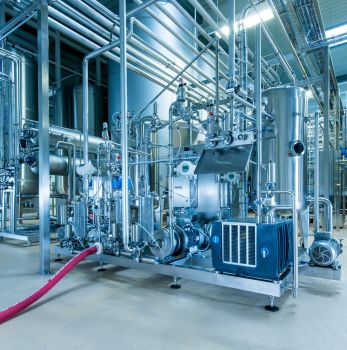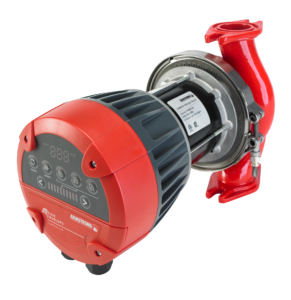PumpMeter by KSB Optimises Fluid Handling in the Life Sciences Industry
Whether a pump is running in its optimum operating range is difficult to judge from the outside. Although vibrations or unusual noise levels are an indicator for irregularities, for a long time we did not know exactly what was happening inside a pump.

Interpretation of current operating point (Image: KSB Aktiengesellschaft)
Since KSB developed the PumpMeter for centrifugal pumps a few years ago, thousands of pumps have been optimised. This helpful tool is now also available for pumps used in hygienically demanding processes.
Despite all endeavours to optimise pump systems, we have found that in real life most pumps are operated far outside their optimum operating range, i.e. nowhere near their best efficiency point. The consequences of operating a pump in the low-flow or overload range are grave: Not only does efficiency remain under the optimum, but the service life and reliability of wear components such as shaft seals and bearings are also reduced.
Since the introduction of PumpMeter in 2010, pump users have been benefiting from a valuable tool. PumpMeter provides information on the pump’s condition via a display so that users can immediately establish how their pump is operating. A typical pump curve illustrates in which range the pump is operating at a particular point of time. This allows the pump user to see at a glance if the pump is operating in an efficient and cost-saving manner, or if its availability might be in jeopardy.
Today, this product has been installed in around 30,000 systems around the world. Offering this product for pumps used in hygienically demanding applications such as the pharmaceutical or food industry was an option considered by KSB right from the start. “Adapting the sensors to meet hygienic standards posed special challenges from a design point of view,” says Daniel Wetter, Life Sciences Product Manager at KSB. “PumpMeter, a product originally designed for standard process conditions, incorporates the kind of uncovered threads and dead volumes that are a no-go for LSA applications as these spaces cannot be cleaned properly.”
Focus on quality and energy costs
In general, energy consumption was not always considered top priority in the pharmaceutical and food industries as their focus was firmly on the quality of the product. In Wetter’s experience: “Although this focus remains in place, energy consumption has meanwhile become a major point of interest.”
A significant factor favouring the installation of PumpMeter is where many of the sensitive fluids handled in these industries require cooling; any form of energy input into the fluid must therefore be avoided. At the same time, the fluid must be handled as gently as possible. “If a pump is operated in the low-flow or overload range, this always entails increased shear forces. Fluids can only be handled gently if the pump is running at its best efficiency point,” adds Wetter.
A further persuasive factor is that a pump running at its best efficiency point always guarantees low maintenance costs. Given the fact that many life science processing companies regularly operate their pumps around the clock, and in some cases, especially during the harvesting periods, they would face catastrophic consequences in the event of pump failure. “A pump that is operated at its best efficiency point has a markedly longer service life,” says Wetter.
Optimally adapted to meet hygienic requirements
Based on the conventional PumpMeter, KSB has developed a variant that is suitable for use in hygienic processes. The main differences between PumpMeter LSA and the conventional PumpMeter are the sensors and the way they are installed in the pipe. The sensors have been designed in accordance with the standard food industry guidelines, i.e. they are EHEDG-certified and comply with the FDA and EN 1935-2004 standards. PumpMeter LSA will be available for KSB’s Vitachrom and Vitacast hygienic pumps.
Normally, when PumpMeter is not used for demanding hygienic processes, it is screwed into the pump via two tapped holes. These tapped holes involve dead volumes, and cleaning the threads is impossible. Sensors used for the food industry are also designed with larger diameters in order to comply with hygienic requirements. Installing the sensor directly into the pump was thus not feasible; adapting the sensor required a fundamentally new approach. “The solution found is an adapter in the form of a socket welded to the pipe by orbital welding in such a way that it is not situated in the no-flow zone,” explains Wetter. “This way, the sensor’s diaphragm is as flush with the pipe as possible.” The diaphragm is also sealed with an O-ring whose material is compliant with FDA requirements. Importantly, the combination of orbital welding socket and sensor has been tested and certified by EHEDG.
Visualising correlations
Like its big brother, PumpMeter LSA comprises pressure sensors as well as an analysing and display unit attached to the pump. It measures suction pressure, discharge pressure and differential pressure. The difference between the two pressures is used to calculate the pump head, including the dynamic head share. For pumps driven by an asynchronous motor operated at a fixed mains frequency the pump speed depends on the torque. The torque, in turn, depends on the motor slip. When the motor load is low (centrifugal pump operating at low flow), the slip is small; when the motor load is high, the slip is large. The correlation between slip, torque, speed and the load on the asynchronous motor is described in engineering literature by the Kloß formula. We can make use of this interdependence to calculate the operating point. First, the precise speed of the pump set is derived from the pressure pulsation caused by the passing impeller vanes. Then, the speed is used as a basis to compute the torque and the pump input power. This method supplies the pump input power in addition to the measured pressures and the head to determine the operating point of the centrifugal pump.
Green stands for optimum
PumpMeter continuously analyses the pump operating data, establishes a load profile and makes the operator aware of energy saving potential that could be leveraged by using a variable speed system. If the EFF (energy efficiency) icon lights up, the unit signals that there is potential for optimisation. However, the tool also offers further information: If many operating hours are being recorded in low-flow conditions and the operating point is moving over a broad range of the characteristic curve, retrofitting a variable speed system is a recommended option. If the operating hours are in the far right of the load profile, the pump set has been operated near the limits of its operating range. Pump and motor overload are likely. “Operators should ask themselves whether they actually need this flow rate,” argues Wetter. “Trimming the impeller might be an option to lower the energy consumption.” Another option could be that the application generally requires a smaller pump type.
Conclusion
There are many reasons why PumpMeter LSA is an interesting product for both the life sciences and the food industry. Alongside reduced maintenance costs, PumpMeter LSA ensures that the fluids involved in these industries’ processes are handled gently and the products’ quality is increased as a result. A further benefit offered by the PumpMeter LSA unit is that it replaces the pressure gauge upstream and downstream of the pump, the pressure transmitter for the control functions and additional monitoring equipment which makes for considerable cost saving. At the same time, the data collected can also be made available to a central process control system via standardised interfaces. This offers potential for further optimisation in the overall process. After comprehensive testing at KSB’s in-house test facility, the units are currently undergoing tests in the field. June this year will see the official sales start of PumpMeter LSA and mark a new era in the life sciences industries in terms of pump optimisation.
Source: KSB SE & Co. KGaA





